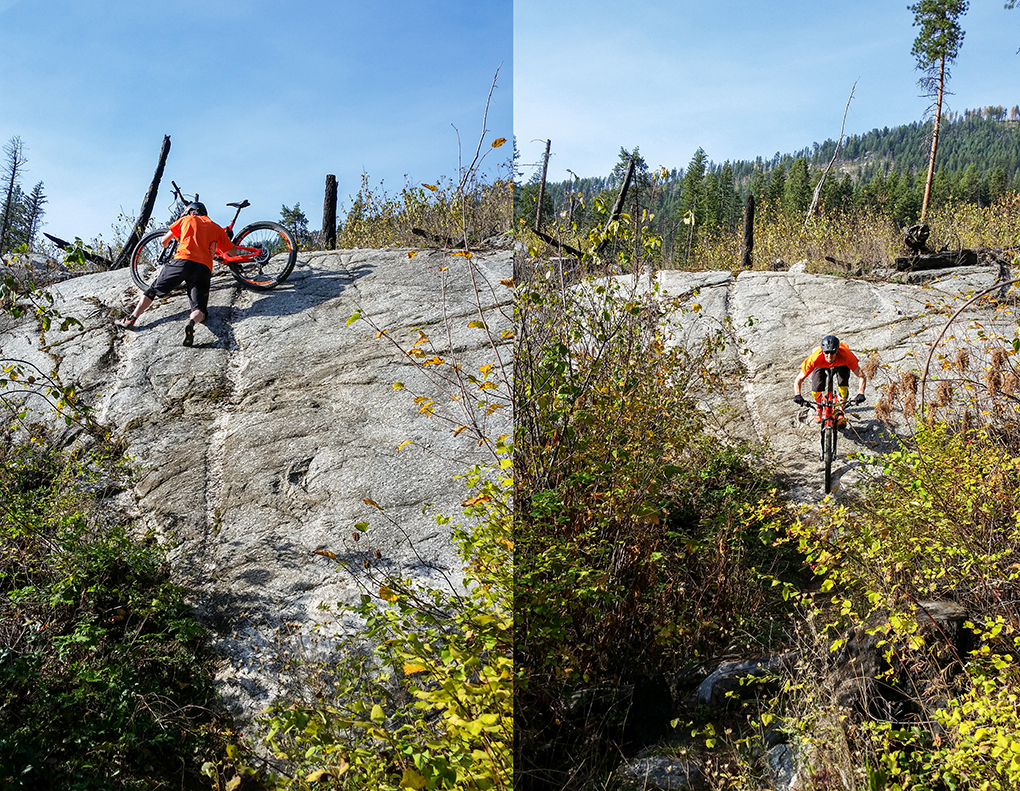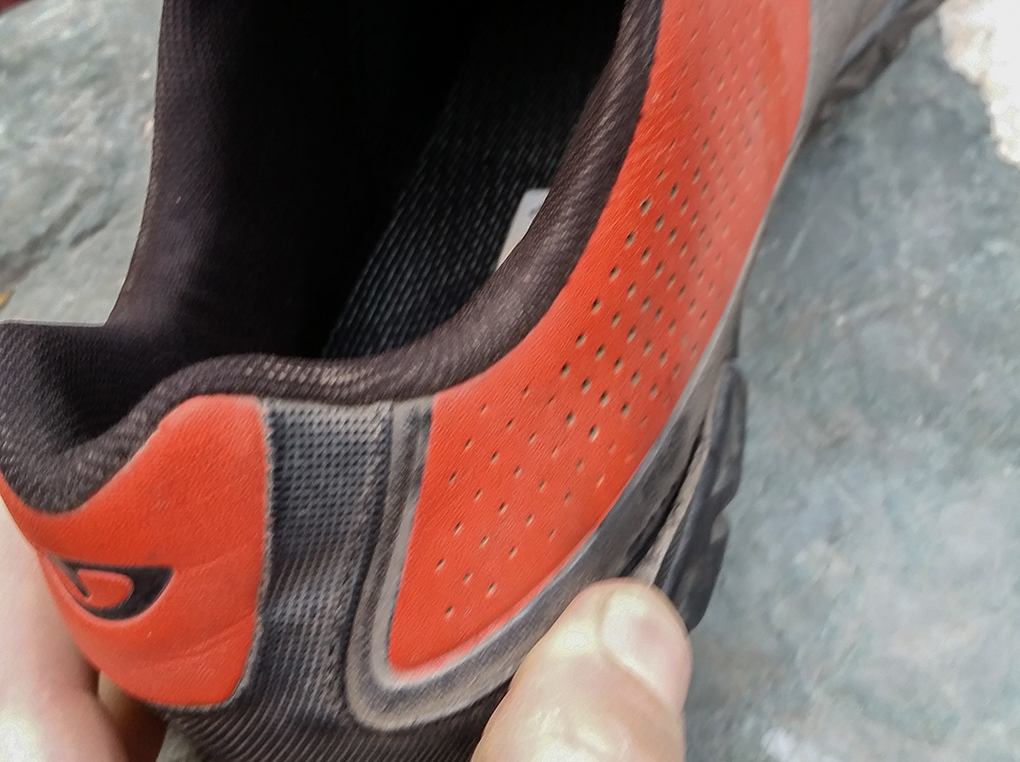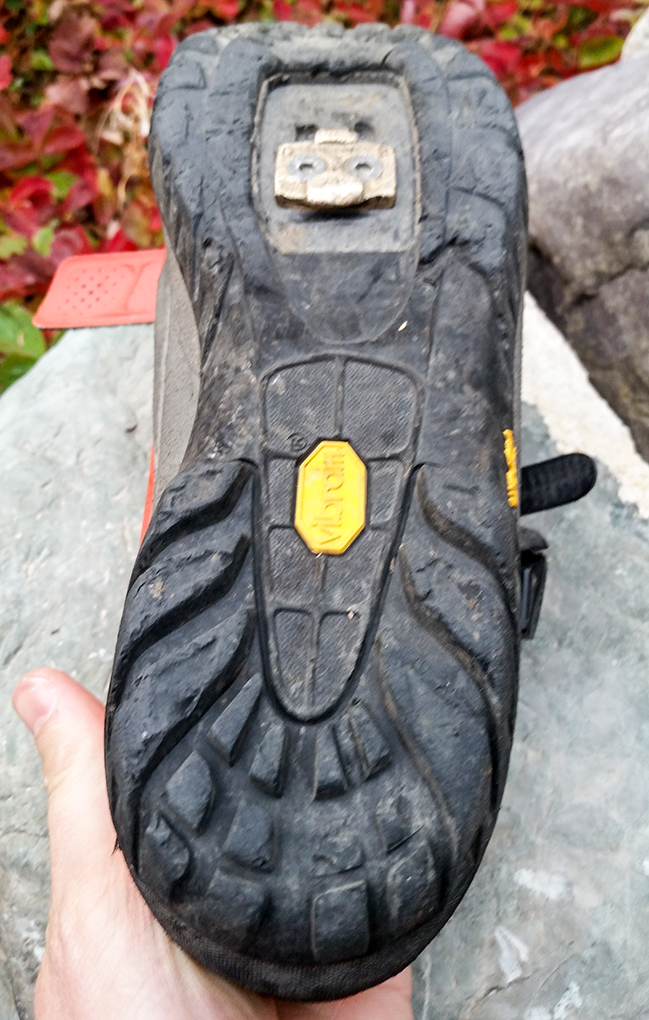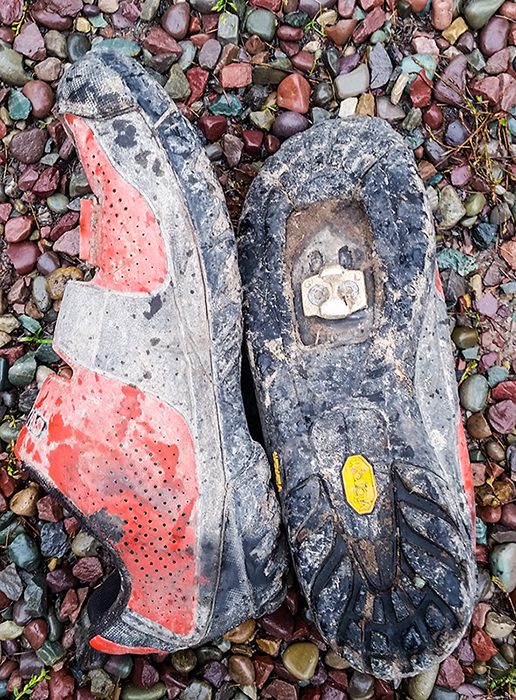2nd Look: Giro Terraduro
Construction:

- Upper: High-quality, breathable microfiber; Strong and secure MR-2 ratcheting buckle closure (replaceable); Offset strap “D-ring” at mid-foot; Rubber toe cap
- Outsole:Molded SPD-compatible shank with optimized cleat zone; Full Vibram® High-traction lugged outsole; Flexible forefoot zone for walking
- Footbed: Molded EVA footbed with medium arch support; Aegis® anti-microbial treatment
Size Tested: 43.5
Blister’s Measured Weight: 901 grams /pair
MSRP: $180
Pedals: Time MX6
Reviewer: 5’9” 155 lbs
Test Duration: ~2 years
Test Locations: Montana and British Columbia
Marshal Olson wrote about his experience with the Terraduro, and the fact that he was disappointed with their durability. He went through two pairs, both of which failed in the same manner: the sole tore away from the body of the shoe.
Giro acknowledged a manufacturing defect, and they sent us out some of the revised versions of the shoe to flog and try to destroy. I’ve spent the last three months beating these shoes up as much as I could, including a bunch of fairly miserable hike-a-bikes up rocky talus slopes. Here’s what I’ve found.
Fit, Stiffness, Etc.
I agree with Marshal’s assessment pretty much across the board regarding fit, stiffness, and the basic functionality of the shoe. I have a fairly low volume foot, and I found the Terraduro to be very comfortable. It’s snug without being too tight, and I agree with Marshal’s “C” width assessment. Lengthwise, my 43.5’s were true to size. The Terraduro’s fit is similar in length to the Giro Code VR70, but the Terraduro is a bit wider and higher volume.
Marshal noted that his wider feet would get cramps after a few hours in the shoes. My skinny feet didn’t have this problem—I did a couple days where I comfortably spent 9 or 10 hours in these shoes, and I never felt the need to loosen them up or anything like that.

The one quirk I found regarding the shape of the shoe was in regard to its compatibility with my Time pedals. The cutout around the cleat wasn’t quite wide enough, and was interfering with my pedals, making it really hard to clip in and out. I shaved a bit of the rubber off around the cleat, and the problem was solved. This isn’t an entirely uncommon problem with Times, but I had to shave more material off the Terraduros than with any other shoe I’ve ridden recently. Ultimately, however, this wasn’t a huge deal.
Durability
Given the previous durability issues of the Terraduro, I’m pleased to report that mine are holding up reasonably well. I’ve put a fair number of miles on them and spent a lot of time walking around on inhospitable surfaces, and they’re in ok shape.
I haven’t seen any indication that the sole is trying to crack or separate, so it seems that Giro has taken care of that problem. The only issue I’ve had is one stitch near the heel letting go.

While it’s not a failure per se, I’d also say that the lugs on the sole are wearing down a bit quicker than I’d like. The lugs near the sole are heavily rounded off, and a couple of the heel lugs have ripped off entirely.

Compared to a variety of other shoes I’ve ridden in the past couple years from a variety of different brands (5.10, Shimano, Teva, and Sidi), I’d say the Terraduro is somewhere on the low end of average in terms of durability.
Bottom Line
In terms of fit and comfort, I’m a fan of the Terraduro—both on and off the bike. Obviously fit is pretty subjective, but they work well with my narrow-ish feet, and I have no problem wearing them for all day rides. They also score points for being stiff enough to not feel like a skate shoe, but they’re still fairly comfortable to walk in. It’s a good blend of walkability and pedaling efficiency.
After three months of riding in these, it seems that Giro has fixed the big durability issues, and while they’re still not the most bombproof shoes I’ve ever owned, they’re not terrible, either. So if you’re looking for a trail-oriented shoe that’s less racy and more comfortable to walk in than something like the Giro Privateer or Code VR70, the Terraduro is certainly a look.
Long Term Update – November 8, 2016
Since writing the initial review, I’ve spent a whole bunch more time in the Terraduro – it’s been the primary shoe that I’ve been riding in for the better part of two seasons now. At a guess, I’d say I have around 150 rides in them – the only time I use something different is for downhilling or if the Terraduros are still wet from the previous day’s ride.
As I noted in the initial review, the first generation Terraduros had some durability issues and the soles were prone to separating from the rest of the shoe. I’m now 100% comfortable saying that Giro has fixed this issue, and all things considered, the Terraduros are holding up pretty well for me. The stitch on the heel that had started to let go in my initial review hasn’t gotten any worse, and aside from normal wear and tear and some rub marks from my cranks, the shoes are still going strong.
I will say that the tread is wearing down a bit quicker than I’d like – it seems to be a slightly softer rubber, which is good for traction but less good for long term lifespan. Here’s what they’re looking like these days:

The normal mode of failure for my shoes is that I snap the sole around where the cleat mounts (which is also usually the flex point of the shoe while walking). Every shoe that I’ve spent a significant amount of time in has, eventually, snapped in that spot. Thus far the Terraduros haven’t snapped, which means they’ve outlasted my Teva Pivots and 5.10 Maltese Falcons.
All in all, I’ve become a big fan of the Terraduro – they hit the right mix of performance and comfort for my purposes. My initial concerns about long term durability turned out to be overblown, and almost two years later, the Terraduros are still on my feet for most of my rides.

You’re lucky then. I had Terraduros for 2 years and had 3 warranty pairs during that time. My latest pair was from Nov 2015, and the durability seemed no better than previous pairs I had. Heel lugs tore off, heel stitching came fully undone, and the nail in the coffin was the sole separating from the toe after a few hike-a-bikes in the Chilcotins. It’s a real shame, because they’re a great shoe function-wise.